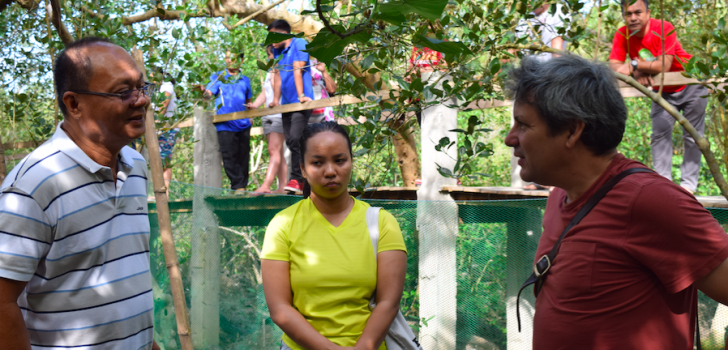 Food and Agriculture Organization NRM Specialist and World Bank Consultant Jim Hancock, CALABARZON RPCO Deputy Project Director Abelardo Bragas, and NRM Officer Elvie Jane Lagan discuss the strategies being implemented by the people’s group and the LGU in the PRDP-subproject and management of coastal resources.
Food and Agriculture Organization NRM Specialist and World Bank Consultant Jim Hancock, CALABARZON RPCO Deputy Project Director Abelardo Bragas, and NRM Officer Elvie Jane Lagan discuss the strategies being implemented by the people’s group and the LGU in the PRDP-subproject and management of coastal resources. PRDP-GEF interventions enhance Bahurang Silag MPA
AGDANGAN, QUEZON– “These incremental efforts provide positive changes inside the MPA and I congratulate you on that,” Jim Hancock said during the site visit in the Bahurang Silag Marine Protected Area (MPA) and “Agdangan Seaweeds Farming and Culturing Projects #1&2” microenterprise (MEP) on November 27 as part of the World Bank Mission to the South Luzon Cluster.
Hancock, a World Bank Natural Resource Management Consultant from the Food and Agriculture Organization, was glad to see huge improvements in the said MPA.
Bahurang Silag fish sanctuary is the only site of the Philippine Rural Development Project – Global Environment Facility (PRDP-GEF) in CALABARZON Region.
“When we first surveyed the fish sanctuary in 2016, the results we got are discouraging–high number of dead corals and low fish biomass,” Ulysses Triambulo, PRDP-GEF NPCO Unit Head, said during the said dialogue on November 27.
Based on the research done in 2016, Bahurang Silag had low scores of 53 points in the METT and 42 points in the MEAT implicating external support is needed to further develop the site.
To assist in the MPA’s rehabilitation, the PRDP-GEF provided the Agdangan Local Government Unit (LGU), proponent groups, and other stakeholders with technical training sessions and materials needed. It also aimed to increase the level of management effectiveness from Level I to Level III.
Likewise, the Agdangan LGU through its Municipal Agriculture Office (MAO) does its share through strengthening the seaboard patrolling and monitoring of the fish sanctuary and nearby body of waters.
“Since the middle of 2018, we have not caught any intruder inside the sanctuary. Our bantay-dagat are more energized to patrol our municipal waters when they see that their efforts have an effect on the conservation of the marine resources,” Joemar Salagubang, Municipal Agriculturist said.
Inside the sanctuary, the share of live hard corals increased from 10% in 2016 to 49% in 2018. Presence of live soft corals also grown in two years. Improvements were also observed in the buffer zone wherein increase in algae, live soft corals and abiotics were recorded
The level of fish biomass inside the sanctuary also went high. From an indicator of 0.23 kilogram in 2016, it has increased to 2.05 kilogram in 2018. The METT score also improved to 92 points while MEAT to 69 points. Most fish species seen are from the families like Chaetodontidae, Pomacentridae, Labridae, Serranidae, and Acanthururidae.
Aside from the rehabilitation efforts, PRDP-GEF also help different associations to develop seaweeds and mangrove crab enterprises.
Six associations were clustered into two for the PRDP-GEF seaweeds production microenterprise in Agdangan. As the subproject undergoes procurement, the PRDP-GEF conducts various techno-demo training on seaweeds farming in partnership with BFAR to prepare the proponent groups in operating the enterprise.
The PRDP-GEF also supports the mangrove crab aquasilviculture techno-demo farm in the municipality. This farm aims to provide additional source of income to the community aside from fishing and seaweeds growing activities.
Meanwhile, Agdangan continues to improve its marine conservation agenda. A future marine protected area in Bahurang Lawis is on the works while an updated fishing ordinance is being deliberated in the municipal council. ### (Lawrence Albert Bariring, DA-PRDP CALABARZON RPCO InfoACE Unit)
